Related Research Articles

The Colony of Virginia was a British colonial settlement in North America between 1606 and 1776.
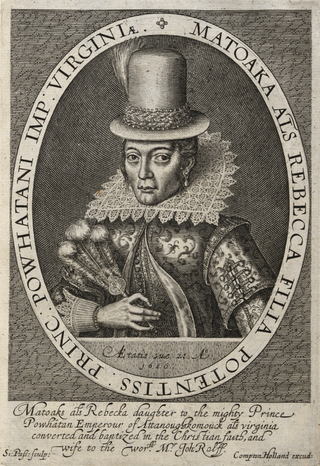
Pocahontas was a Native American woman belonging to the Powhatan people, notable for her association with the colonial settlement at Jamestown, Virginia. She was the daughter of Powhatan, the paramount chief of a network of tributary tribes in the Tsenacommacah, encompassing the Tidewater region of what is today the U.S. state of Virginia.

John Rolfe was an English explorer, farmer and merchant. He is best known for being the husband of Pocahontas and the first settler in the colony of Virginia to successfully cultivate a tobacco crop for export.

Opechancanough was paramount chief of the Powhatan Confederacy in present-day Virginia from 1618 until his death. He had been a leader in the confederacy formed by his older brother Powhatan, from whom he inherited the paramountcy.

Sir George Yeardley was a planter and colonial governor of the colony of Virginia. He was also among the first slaveowners in Colonial America. A survivor of the Virginia Company of London's ill-fated 1609 Third Supply Mission, whose flagship, the Sea Venture, was shipwrecked on Bermuda for ten months, he is best remembered for presiding over the initial session of the first representative legislative body in Virginia in 1619. With representatives from throughout the settled portion of the colony, the group became known as the House of Burgesses. Burgesses have met continuously since, and is known in modern times as the Virginia General Assembly.
In the seventeenth century, Kecoughtan was the name of the settlement now known as Hampton, Virginia. In the early twentieth century, it was also the name of a town nearby in Elizabeth City County. It was annexed into the City of Newport News in 1927.
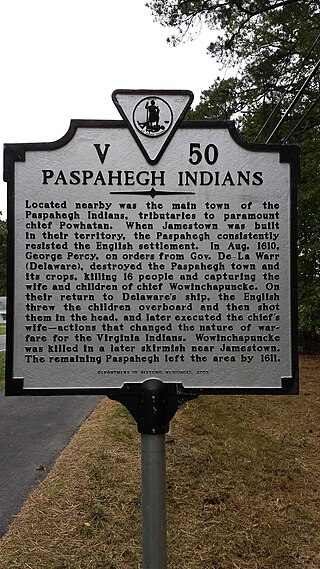
The Paspahegh tribe was a Native American tributary to the Powhatan paramount chiefdom, incorporated into the chiefdom around 1596 or 1597. The Paspahegh Indian tribe lived in present-day Charles City and James City counties, Virginia. The Powhatan Confederacy included Indigenous peoples of the Northeastern Woodlands who spoke a related Eastern Algonquian languages.
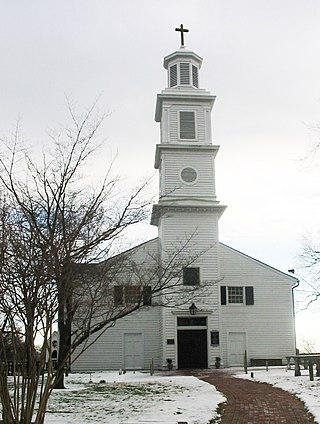
St. John's Church is an Episcopal church located at 2401 East Broad Street in Richmond, Virginia, United States. Formed from several earlier parishes, St. John's is the oldest church in the city of Richmond, Virginia. It was built in 1741 by William Randolph's son, Colonel Richard Randolph; the Church Hill district was named for it. It was the site of two important conventions in the period leading to the American Revolutionary War, and is famous as the location where American Founding Father Patrick Henry gave his memorable speech at the Second Virginia Convention, closing with the often-quoted demand, "Give me liberty, or give me death!" The church is designated as a National Historic Landmark.
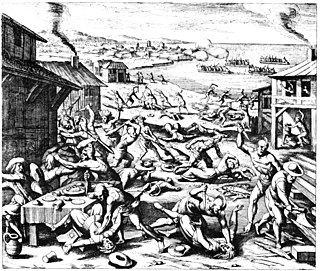
The Indian massacre of 1622 took place in the English colony of Virginia on March 22, 1621/22 (O.S./N.S.). English explorer John Smith, though he was not an eyewitness, wrote in his History of Virginia that warriors of the Powhatan "came unarmed into our houses with deer, turkeys, fish, fruits, and other provisions to sell us"; they then grabbed any tools or weapons available and killed all English settlers they found, including men, women, and children of all ages. Opechancanough, chief of the Powhatan Confederacy, led a coordinated series of surprise attacks that ended up killing a total of 347 people — a quarter of the immigrant population of the Colony of Virginia.
Wolstenholme Towne was an English settlement in the Colony of Virginia, 7 miles (11 km) east of the colonial capital, Jamestown. One of the earliest English settlements in the New World, the town existed for roughly four years until its destruction in the Indian massacre of 1622. The Wolstenholme Towne site was later built upon by the Carter's Grove plantation in 1750 and is located within the present-day community of Grove, Virginia, United States.
Martin's Hundred was an early 17th-century plantation located along about ten miles (16 km) of the north shore of the James River in the Virginia Colony east of Jamestown in the southeastern portion of present-day James City County, Virginia. The Martin's Hundred site is described in detail in the eponymous book of Ivor Noel Hume first published in 1979.
Elizabeth City was one of four incorporations established in the Virginia Colony in 1619 by the proprietor, the Virginia Company of London, acting in accordance with instructions issued by Sir George Yeardley, Governor. This allowed the crown to benefit from the offerings of the new land, including its natural resources, new markets for English goods, and the leverage it provided against the Spanish.
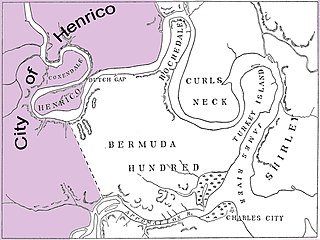
The City of Henrico is one of the oldest counties in the Colony of Virginia. It was one of four incorporations established in the colony by its proprietor, the Virginia Company. The City of Henrico, which included the settlement of Henricus, was the furthest incorporation upstream on the James River. In 1634, Henrico was reorganized under royal authority as the shire of Henrico, one of eight shires in the Crown Colony of Virginia, Later, it became known as Henrico County, Virginia.
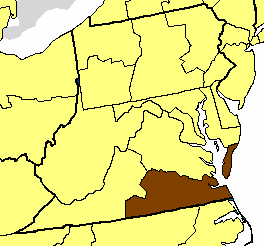
Episcopal Diocese of Southern Virginia is the diocese of the Episcopal Church in the United States of America located in the southeast area of Virginia. It is in Province III. The diocese includes the Hampton Roads area, Richmond south of the James River, most of the region known as Southside Virginia, and both Northampton and Accomack Counties of the Eastern Shore of Virginia.
Berkeley Hundred was a Virginia Colony, founded in 1619, which comprised about eight thousand acres (32 km2) on the north bank of the James River. It was near Herring Creek in an area which is now known as Charles City County, Virginia. It was the site of an early documented Thanksgiving when the settlers landed in what later was the United States. In 1622, following the Indian Massacre of 1622, the colony was for a time abandoned. In the mid 18th century, it became known as Berkeley Plantation, the traditional home of the Harrison family of Virginia. In 1862, amid fighting in the Civil War, the area was the scene of the creation and first bugle rendition of present-day "Taps".

Jamestown, also Jamestowne, was the first settlement of the Virginia Colony, founded in 1607, and served as the capital of Virginia until 1699, when the seat of government was moved to Williamsburg. This article covers the history of the fort and town at Jamestown proper, as well as colony-wide trends resulting from and affecting the town during the time period in which it was the colonial capital of Virginia.

St. John's is an Episcopal church located in Hampton, Virginia, United States, within the Episcopal Diocese of Southern Virginia. Established in 1610, St. John's is the oldest English-speaking parish in continuous existence in the United States of America.
William Powell, was an early Virginia colonist, landowner, militia officer and legislator. Considered an ancient planter for living in the Virginia colony during its first decade, he was one of two representatives from what became James City County, Virginia in the first Virginia House of Burgesses in 1619. His former plantation, now across the James River in Surry County, Virginia is now within Chippokes State Park.
George Thorpe, was a noted landowner, Member of Parliament, distiller, educator and major investor in early colonial companies in the Americas.
This is a timeline of events related to the settlement of Jamestown, in what today is the U.S. state of Virginia. Dates use the Old Style calendar.
References
- ↑ Tyler, Lyon G (1906). The Cradle of The Republic: Jamestown and James River. Richmond, VA: The Hermitage Press, Inc. pp. 187 . Retrieved September 2, 2009.
cradle of the republic jamestown.
- 1 2 3 Tormey, James (April 2009). How Firm a Foundation. Richmond, VA: Diets Press. p. 184. ISBN 978-0-87517-135-7.
- 1 2 Brydon, George Maclaren (1947). Virginia's Mother Church. Richmond, VA: Virginia Historical Society. pp. 571 . Retrieved September 22, 2009.
- 1 2 St. John's Altar Guild (December 23, 2015). The Altar Guild Handbook. Hampton, Virginia: St. John's Episcopal Church. p. 37.